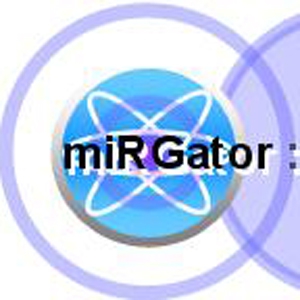Status:
Platform:
Species:
MicroRNAs (miRNAs) constitute an important class of regulators that are involved in various cellular and disease processes. However, the functional significance of each miRNA is mostly unknown due to the difficulty in identifying target genes and the lack of genome-wide expression data combining miRNAs, mRNAs and proteins. We introduce a novel database, miRGator, that integrates the target prediction, functional analysis, gene expression data and genome annotation. MiRNA function is inferred from the list of target genes predicted by miRanda, PicTar and TargetScanS programs. Statistical enrichment test of target genes in each term is performed for gene ontology, pathway and disease annotations. Associated terms may provide valuable insights for the function of each miRNA. For the expression analysis, miRGator integrates public expression data of miRNA with those of mRNA and protein. Expression correlation between miRNA and target mRNA/proteins is evaluated and their expression patterns can be readily compared. Our web implementation supports diverse query types including miRNA name, gene symbol, gene ontology, pathway and disease terms. Interfaces for exploring common targets or regulatory miRNAs and for profiling compendium expression data have been developed as well. Currently, miRGator, available at: http://genome.ewha.ac.kr/miRGator/, supports the human and mouse genomes.[1]
miRGator is an integrated database of microRNA (miRNA)-associated gene expression, target prediction, disease association and genomic annotation, which aims to facilitate functional investigation of miRNAs. The recent version of miRGator v2.0 contains information about (i) human miRNA expression profiles under various experimental conditions, (ii) paired expression profiles of both mRNAs and miRNAs, (iii) gene expression profiles under miRNA-perturbation (e.g. miRNA knockout and overexpression), (iv) known/predicted miRNA targets and (v) miRNA-disease associations. In total, >8000 miRNA expression profiles, ~300 miRNA-perturbed gene expression profiles and ~2000 mRNA expression profiles are compiled with manually curated annotations on disease, tissue type and perturbation. By integrating these data sets, a series of novel associations (miRNA-miRNA, miRNA-disease and miRNA-target) is extracted via shared features. For example, differentially expressed genes (DEGs) after miRNA knockout were systematically compared against miRNA targets. Likewise, differentially expressed miRNAs (DEmiRs) were compared with disease-associated miRNAs. Additionally, miRNA expression and disease-phenotype profiles revealed miRNA pairs whose expression was regulated in parallel in various experimental and disease conditions. Complex associations are readily accessible using an interactive network visualization interface. The miRGator v2.0 serves as a reference database to investigate miRNA expression and function (http://miRGator.kobic.re.kr).[2]
Biogenesis and molecular function are two key subjects in the field of microRNA (miRNA) research. Deep sequencing has become the principal technique in cataloging of miRNA repertoire and generating expression profiles in an unbiased manner. Here, we describe the miRGator v3.0 update (http://mirgator.kobic.re.kr) that compiled the deep sequencing miRNA data available in public and implemented several novel tools to facilitate exploration of massive data. The miR-seq browser supports users to examine short read alignment with the secondary structure and read count information available in concurrent windows. Features such as sequence editing, sorting, ordering, import and export of user data would be of great utility for studying iso-miRs, miRNA editing and modifications. miRNA-target relation is essential for understanding miRNA function. Coexpression analysis of miRNA and target mRNAs, based on miRNA-seq and RNA-seq data from the same sample, is visualized in the heat-map and network views where users can investigate the inverse correlation of gene expression and target relations, compiled from various databases of predicted and validated targets. By keeping datasets and analytic tools up-to-date, miRGator should continue to serve as an integrated resource for biogenesis and functional investigation of miRNAs.[3]
References
- miRGator: an integrated system for functional annotation of microRNAs.,
, Nucleic Acids Res, 2008 Jan, Volume 36, Issue Database issue, p.D159-64, (2008)
- miRGator v2.0: an integrated system for functional investigation of microRNAs.,
, Nucleic Acids Res, 2011 Jan, Volume 39, Issue Database issue, p.D158-62, (2011)
- MiRGator v3.0: a microRNA portal for deep sequencing, expression profiling and mRNA targeting.,
, Nucleic Acids Res, 2013 Jan, Volume 41, Issue Database issue, p.D252-7, (2013)







